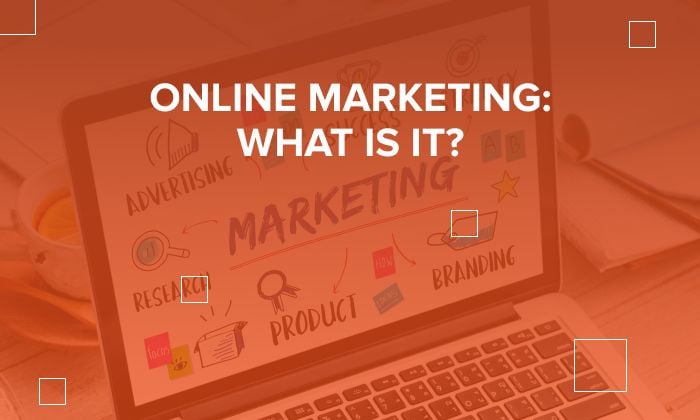
Do you know who Timothy Armoo is? He’s the CEO and co-founder behind the social media agency Fanbytes.
If you’re an online marketing nerd like me, you probably do.
However, if you’re part of the other 99.9% of the world who isn’t super excited about this “Internet marketing stuff” you’ve probably never heard of this man.
OK, so he’s not a mega-famous, super-celeb type, but this online marketing star got people talking when he sold his startup for eight figures.
You know what Armoo excels at? (apart from online marketing, of course). It’s his ability to:
- Adapt to change
- Focus on smaller niches to stand out
- Outperform other ads on social media
Yet despite his massive success, most people don’t know who Armoo is.
If you’re an introvert, that’s a cause to celebrate!
Fewer than 20 years ago, extroverts had a way better chance of becoming rich and successful.
Why? It involved a ton of networking.
You had to hire employees and build a huge company. Or, for a career in arts, music, movies, etc., you had to get every person in your industry to know you.
While connections are still a huge deal, today you can get them right from your couch (or from your living room floor in my case).
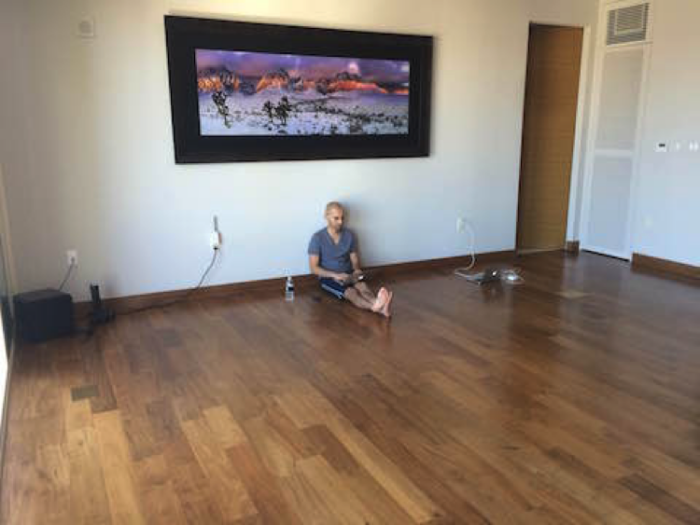
As a single individual, you can build a huge business from the comfort of your home after work, during your afternoons, and on your weekends.
I don’t think that I’m being overly dramatic when I say that online marketing is your shot at the life of your dreams.
Trust me, I would know.
I want you to have as much fun at work as these guys and I do. That’s why, today, I’m introducing you to this world with my online marketing guide.
Note: Even if you’re deep down the rabbit hole already, you can still learn a ton of new things from the following examples.
If you’re interested in a particular topic, feel free to jump ahead:
- Definition of Online Marketing
- Overview/Types of Online Marketing
- SEO – Search Engine Optimization
- On-Page SEO
- Off-Page SEO
- SEM – Search Engine Marketing
- Content Marketing
- Why Content Marketing?
- Social Media Marketing
- Pay-Per-Click Advertising
- Everything That You Need To Know About Google Ads
- Affiliate Marketing
- Email Marketing
Definition of Online Marketing
Not every digital marketing campaign is automatically an online marketing effort. There are some differences.
As MooSend explains, online marketing is “a strategy that entails using digital channels to reach your audience. In comparison to traditional marketing, this method is more cost-effective and has better chances of increasing brand awareness through personalized messages.”
Want the drop-dead simple version of it?
Basically, it’s anything that you do online to get more eyeballs on you, grab people’s attention, and hopefully, at some point, get them to buy from you.
There are seven major sub-categories of online marketing that I want to cover in this guide.
Overview and Types of Online Marketing
If you’ve read my SEO guide, it’s a great resource on what it is and all of the important aspects of it that you have to get right. Basically, it’s all the changes and tactics you can use to increase the rankings and visibility of your content in organic searches.
Next to SEO, there’s search engine marketing (SEM), which is simply the paid version of SEO.
Marketers pay Google to display ads in its search results in the hopes that they drive traffic (especially interested people, or leads) to their product landing pages.
Then there’s content marketing. This is where marketers try to create valuable media and content to distribute to potential future customers. This is the good-guy version of online marketing where you mostly try to guilt people into buying.
Of course, you already know social media marketing, which is where you use one or several social media channels to engage with customers, build relationships, and then send them to your products and services.
Pay-per-click advertising (or PPC) is similar to search engine marketing, but it isn’t limited to Google and its competitors. Most social media networks let you create ads that integrate naturally into their feeds, allowing you to pay for clicks to your website.
Affiliate marketing is a kind of referral marketing where you share profits with fellow marketers in exchange for promoting each other’s products.
And finally, there’s email marketing, which some already consider old-school. However, it’s still one of the most effective channels with an average ROI of 42 percent for every dollar spent and an average open rate across all industries of 21.33 percent. Once your customers have given you permission to contact them, you can email them at any time, but, you may find 8-9 AM is the best time to send them. However, it doesn’t matter what time you send your emails if they aren’t relevant to your audience and if they don’t add value.
You can already guess how big online marketing really is. You know how huge of a space each of these individual categories fill.
I mean, just think about how many social media platforms you can name off the top of your head:
Facebook, Pinterest, Twitter, Instagram, Snapchat, Tumblr, YouTube, LinkedIn, Reddit, TikTok…
OK, you get the point.
I want to give you a good grip on all of these categories just like in our beginner’s guide, yet not drown you in the vast information that’s out there.
Ready. Set. Go!
SEO – Search Engine Optimization
It goes without saying that I think the Neil Patel blog is one of the best resources around when it comes to SEO (we’re kind of a big deal, I think).
However, instead of spending an entire category bragging, I’ve linked to some of my articles below:
The following three blog posts are some of the best ones to help you get started:
- A New Way to Do Keyword Research
- A Simple Step-by-Step Guide to SEO
- 11 Critical Google Ranking Factors That Will Drive Traffic
Within search engine optimization, there are two big sectors to be aware of:
On-page and off-page SEO.
On-page SEO involves optimizing individual web pages to rank higher and earn more relevant traffic from search engines. This includes optimizing content, HTML, and other coding elements that are part of a webpage.
It also involves engaging in practices such as keyword research, broken link checking, meta tag creation, image optimization, and many more. All these steps help optimize your site for search engine algorithms so that it ranks higher in SERPs.
Off-page SEO is all about creating relationships to other websites and building trust with your customers. By engaging in off page SEO activities, you are creating backlinks, which can help boost your website’s visibility and rankings on the major search engines.
At its core, off-page SEO involves optimizing content outside of your website that links back to it. This includes activities such as link building, social media engagement, content syndication, guest posting on other blogs or websites, and influencer marketing. Each of these activities helps create more backlinks that point to your website and help increase its authority in the eyes of Google and other search engines.
Let’s dive into each.
On-Page SEO
Over the past few years, Google has made countless updates to its algorithms.
Data tells us that Google makes thousands of changes to its algorithm every single year.
It’s almost impossible to keep up with Google’s rapid pace and changing user behavior.
However, one thing that’s remained relatively constant is conducting on-page SEO.
Some on-page activities for SEO aren’t linked to direct ranking factors but rather to indirect factors like click-through rate and time on site.
For example, an on-page SEO task that’s common is to optimize your meta description and title tag:
Your title tag and meta description are what shows up on a given Google search result. For example, if someone searches for “SEO Tips,” my post, ‘The 10 Most Important SEO Tips You Need to Know’ appears:

While placing keywords in the title and description can help users navigate the content faster (as seen by the bolded text), it doesn’t directly increase rankings; simply stuffing keywords in your meta and title tags isn’t an option. In fact, as Google’s algorithm gets smarter, you can get penalized for actions like that.
However, they do contribute to the click-through rate. When your title tags and meta descriptions are more compelling or related to the topic that someone is searching for, you can expect higher click-through rates.
The higher the CTR, the higher the chance of ranking better. Google is all about providing the best user experience possible. So if Google notices that your post that ranks at #10 is getting a higher CTR than the post above you, they will move your content up.
On-page SEO consists of a few major elements to be aware of:
- Crawl errors
- Keyword research
- Page speed optimization
- Speed
In this section, I’ll walk you through how you can improve each of these elements to get your on-page SEO on the right track.
Crawl Errors
Crawl errors can be anything from a 404 error (broken link) to duplicate content. And all of these issues can plague your website with:
- Slow speeds
- Impacted rankings
- Penalties from Google
- Increased risk of users leaving your site (bouncing)
If you’ve ever seen this on your site, it’s a broken link error that can cause major problems:
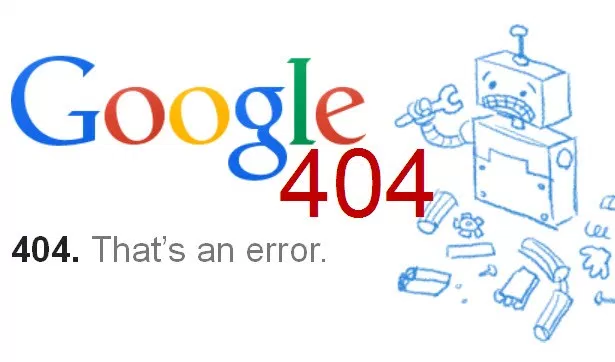
For example, 404 errors can impact your traffic heavily if another external source is linking to them.
If you’ve gotten your content featured on another site, but the link is broken, you’re losing out on tons of traffic.
One of the fastest tools to fix crawl errors that could be harming your site is Screaming Frog.
It’s a technical SEO tool that can scan your website for free, telling you detailed information on what you need to fix and how to do it:
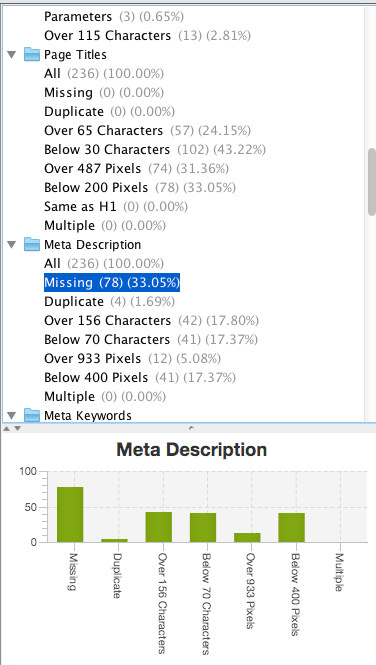
When scanning your site, be sure to look for common problem areas like:
- Duplicate or missing content
- 404 errors
These issues are all too common on the majority of sites.
Keyword Research
Keyword research is a fundamental process in any online marketing game plan for SEO.
Keywords are what you search in a search engine to find the content you are looking for.
For example, type “SEO Guide” into Google — that would be a keyword. And pages can target these keywords to compete in the rankings.
There are a few types of keywords to be aware of before conducting a basic keyword research strategy. There are two major kinds:
- Long-tail keywords: Long-tail keywords are longer keywords made up of 3-5+ words. They are often easier to target due to specificity, less traffic, and less competition.
- Short tail keywords: Head or short-tail keywords are one-word or two-word keywords that are more general. For example, “basketball shoes” would be a competitive head keyword.
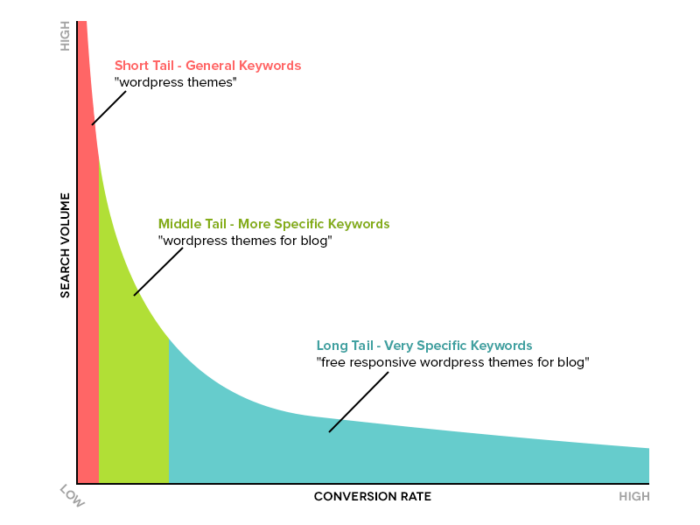
A good SEO strategy will target a mixture of both of these kinds of terms.
Short-tail keywords will be much more competitive because they are more general (and therefore have a higher volume).
On the other hand, long-tail keywords will get you less traffic but will convert better.
To conduct keyword research, all you need to do is head to a keyword tool like Moz or the Google Ads Keyword Planner.
Simply start by entering the basic topic that you want to cover for your next post or page:
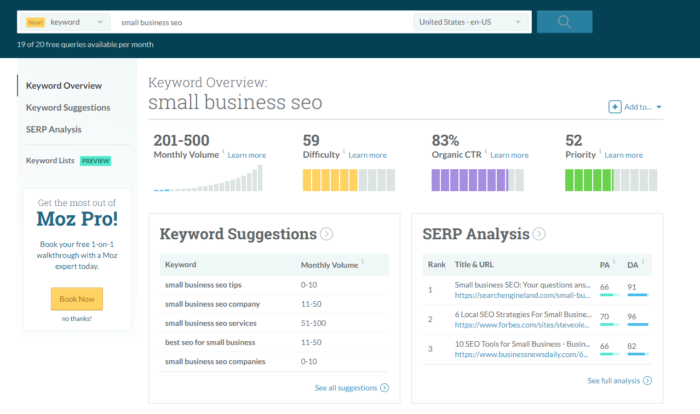
Searching for your basic keyword will give you a list of metrics telling you the volume (how many searches per month), difficulty (competition ranking for it), and the number of clicks that come from organic search.
Lastly, it will also give you keyword suggestions.
Generally speaking, when looking to target keywords for your next blog post, you want to find long-tail terms with higher volumes and lower difficulty scores.
Then, you can take that keyword and follow the next steps under page optimization!
Content Optimization
Content optimization is a crucial part of any website; it can make or break the success of an online marketing venture.
It’s all about making sure your website is easy to navigate, and contains content that’s properly optimized for search engine algorithms.
Some areas you can focus on are:
- adding internal links
- keyword selection
- optimizing URLs and titles
- marking up headings
However, you’re writing content and optimizing pages for both the user and the search engine. Write for humans, not machines.
Here’s an example of why page optimization is so vital for your online marketing strategy. when you search for an article on Google, you expect to get something similar to your search:
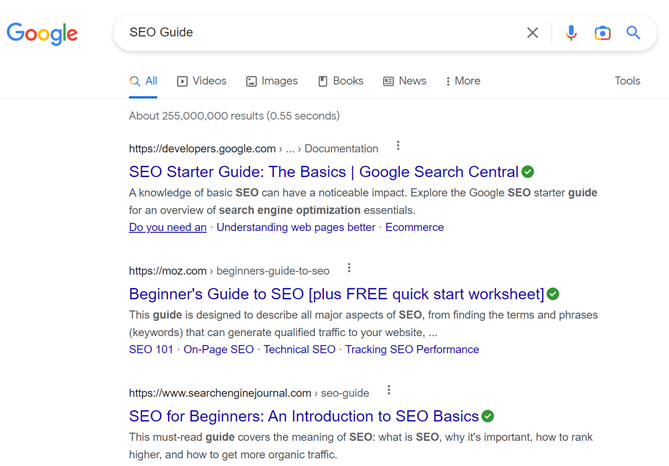
Everything from the permalink (URL) to the title and structure of your post (h1 and h2 headings) makes a difference in how Google scans your content and how user-friendly it is.
The better on-page optimization you have, the longer users will stay around to consume your content.
Plus, optimizing things like internal links (where you link to another article on your site from a new post) will help you drive users throughout your entire site.
Improve Your Page Speed Optimization
One of the biggest factors for success is improving the speed at which your page loads.
When it comes to SEO, you want your content to load fast. Google prefers websites that load fast as well.
Studies have shown time that page speed affects consumers’ attitudes toward your website, too:
- Almost 70 percent say page load speed impacts their likelihood of buying
- 26.9 percent of internet users only wait 1-3 seconds for a page to load.
- 22 percent say they would try and refresh a slow-loading site, while 14 percent would go to a competitor.
Thankfully, Google offers free tools like Pagespeed Insights to help you to optimize page speed across all devices each of these can help you improve your site speed dramatically.
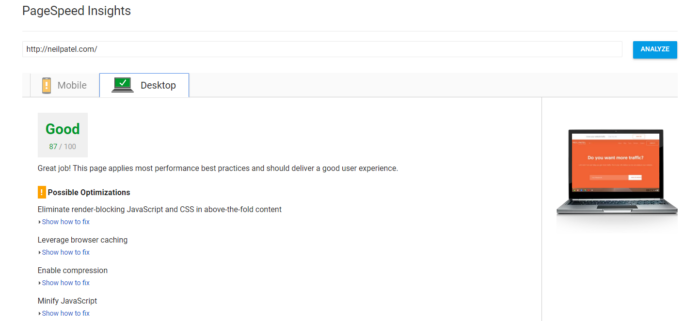
You could also try Pantheon for testing speed.
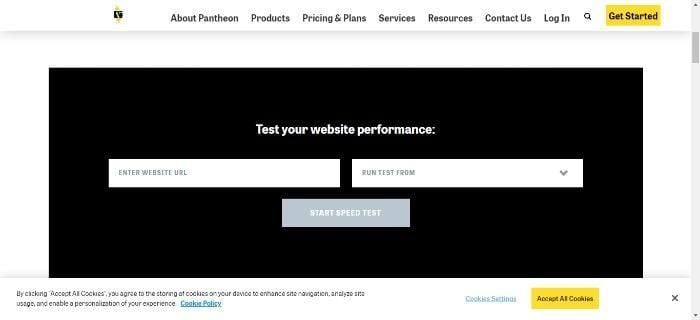
When you improve your site speeds, you can expect users to stay around on your site, reducing bounce rates that can negatively impact your organic rankings.
Always continue to test your site speed and improve where you can. These tools will help you fix any lingering problems by offering detailed, step-by-step solutions under each problem area.
Off-Page SEO
What’s off-page SEO? It’s simply the opposite of on-page SEO and means everything you do offsite to increase your site’s rankings.
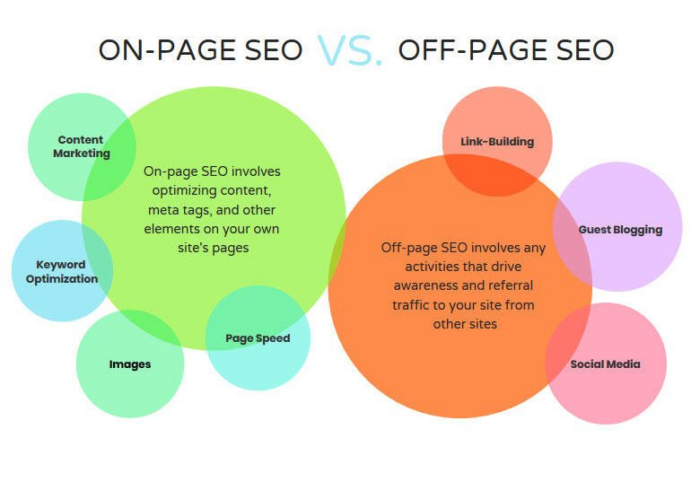
There are a few major ways that off-page SEO comes into play. Everything from link building to social media promotion and content syndication can improve your off-page SEO.
Even things like guest blogging or writing a promotional piece on another site can result in a link (i.e., off-page SEO). Link building is a tried and tested technique, and still crucial now. According to Ahrefs, link building is one of the top three Google ranking factors. Additionally, when Ahrefs disavowed links to study the impact on traffic, pages lost up to 18 percent of visitors.
It’s no secret that quality backlink count tends to correlate with strong rankings: The more links you have back to your site from other sites, the stronger authority you have in the eyes of Google.
Link building is tough, but it’s necessary to compete with your competitors and help with coveted positions in the SERP.
Ranking higher with links involves everything from your total number of links to the quality of those links and the diversity of the sources.
When it comes to getting links, you need great content. The majority of content ranking #1 on Google is stellar, and that’s why they have thousands of links. The content is nearly unmatched!
In Moz’s article “How to Rank on Google,” they explain the 50/50 rule of link building:
‘When building link-worthy content, spend 50 percent of your time actually creating the content itself, and 50% of your time promoting it.’
Without great content, you won’t get the links you need to bring in more traffic and drive sales.
One of my favorite ways to build backlinks fast is by mentioning other influencers in my content. This adds great value to your content while also mentioning and giving praise to others.
This works well because we all know humans love it when people lift their egos. It’s a great feeling to get compliments and praise for your knowledge in a space.
By tapping into that and getting value and input from influencers, you can easily drive backlinks. For example, Themexpert mentions me in its list of best digital marketing blogs.
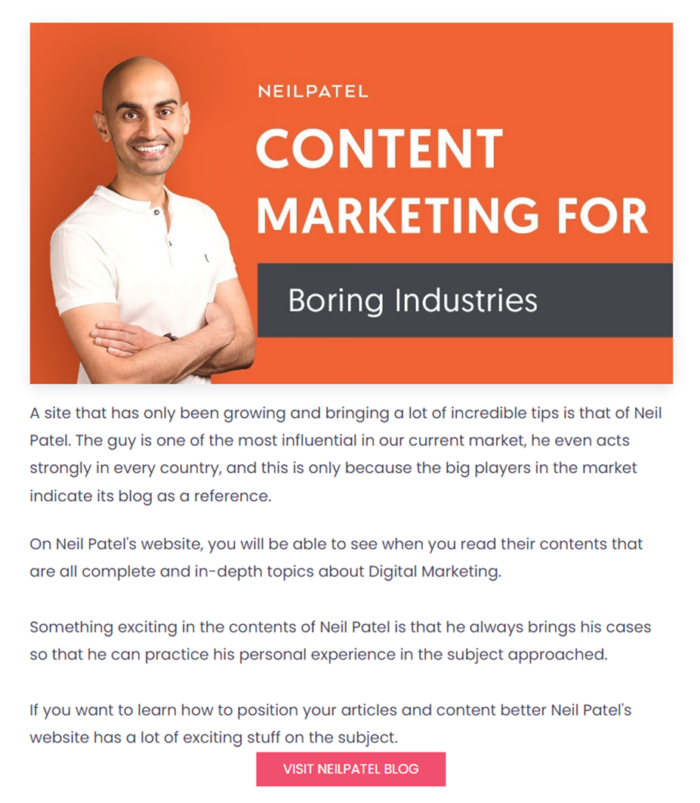
Mentioning influencers is a great way to get them to share your post!
For more methods on building backlinks, here are a few key resources:
- How to Get Backlinks For A New Site With No Money
- 9 Link Building Resources That’ll Increase Your Search Rankings
- 13 Efficient Link Building Strategies for Busy Marketers
Social Sharing
Social publishing is a great way to indirectly contribute to your off-page SEO strategy. While it’s not a direct ranking factor, it’s an off-page tactic that can lead to more backlinks.
Sharing your latest post on social media helps to spread it to new audiences. The more users you attract, the more brand awareness you get, and hopefully, the more links you can get as well.
Try using a tool like Buffer to schedule your content in advance:
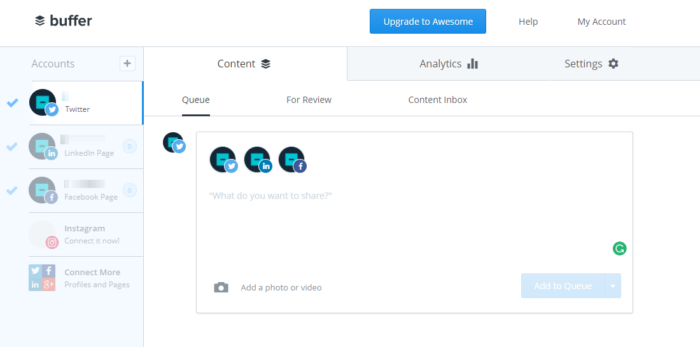
Using platforms like LinkedIn is one of my favorite ways to conduct off-page SEO with social media as well.
Beyond simply sharing your latest posts, a great strategy is to write articles on LinkedIn, directing traffic back to your site.
Let me show you an example of an article I posted on LinkedIn.
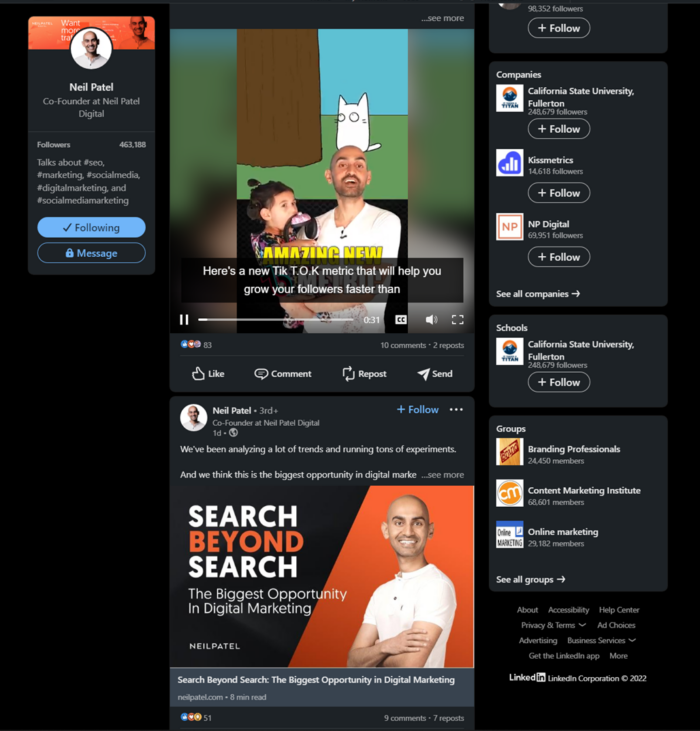
LinkedIn content is much different than simply pasting your material into the status update bar. When you publish content on LinkedIn, it alerts all of your connections each time a new article goes live. That means that everyone who follows you gets a notification rather than having to stumble across it while scrolling through a timeline.
My favorite strategy for LinkedIn articles is to copy the introduction paragraph of my latest blog post and end it with [click to continue reading…].
I then hyperlink that phrase back to my full blog post on my site, driving tons of traffic and engagement!
To get started with this off-page SEO tactic, head to LinkedIn and select “Write an article:”

Next, add your featured image from your blog post and copy and paste the headline and intro paragraph:
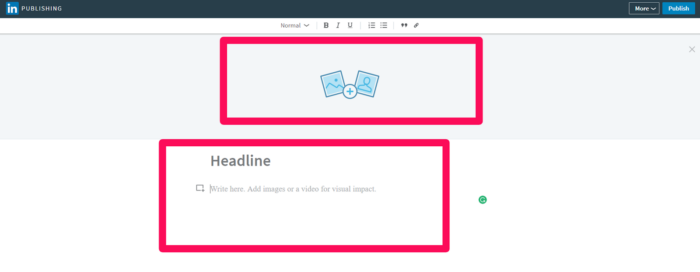
Add your “click to continue reading” tag at the end and watch your traffic and links skyrocket.
Search Engine Marketing (SEM)
Search engine marketing is the paid cousin of SEO.
Instead of optimizing your content and promoting it a lot to eventually show up as a top result for organic search engine results (which can often take a few months to happen even if you do it right), you can pay your way to the top.
Since it’s the first thing searchers see on the page, you’ll likely get a lot of hits to your site. However, you also pay for each and every one.
Google results look different now, although Ads still show first:

Depending on what keyword you want to show up for, you pay different prices.
The keywords that people search a lot for are more competitive and are, therefore, more expensive.
Some keywords can cost several hundred dollars per click. Others cost $600 for a single click! While ads are a great strategy, it only works if you can immediately recoup your advertising costs.
Companies easily blow tens of thousands of dollars on Google Ads campaigns, failing to make sure that they get their money’s worth.
To win with SEM, you have to offer a paid product or service.
When you’re still in the phase of producing free content to build an audience, don’t waste your time with SEM. You’ll run out of money faster than you can spell S-E-M.
Thankfully, avoiding the mistake of paying for worthless clicks is not as hard as you might think.
By setting up conversion goals inside of your campaign, you can track exactly who made a purchase from your ads, and you’ll know exactly how much money you spent and how much you made at any time.
If you need inspiration, there are plenty of success stories about brands that have yielded significant returns from running Google Ads. For example, a medical software company, Samedi, increased returns by up to 85 percent, while Kinetica Sports recorded a 267 percent return on ad spend.
With an informed and focused approach to Google Ads, you could do the same.
Content Marketing
Jon Morrow is a master content crafter. After getting annoyed by how great content often suffers from little traffic and exposure, he set out to help people change that.
His blog, SmartBlogger.com, boasts over 300k subscribers and four million readers.
As I taught you in the previous guide, content marketing is all about providing timely and relevant value to your audience.
The first step to doing that is knowing your stuff, and Jon did his homework! He’s built his blog into a six-figure monthly income.
That’s right: He makes more in a month than most people earn in a year. From that, it’s fair to assume that he excels at online marketing.
The most remarkable thing about Jon’s blog? He did all of it with just the power of his voice. Jon is paralyzed from the neck down:
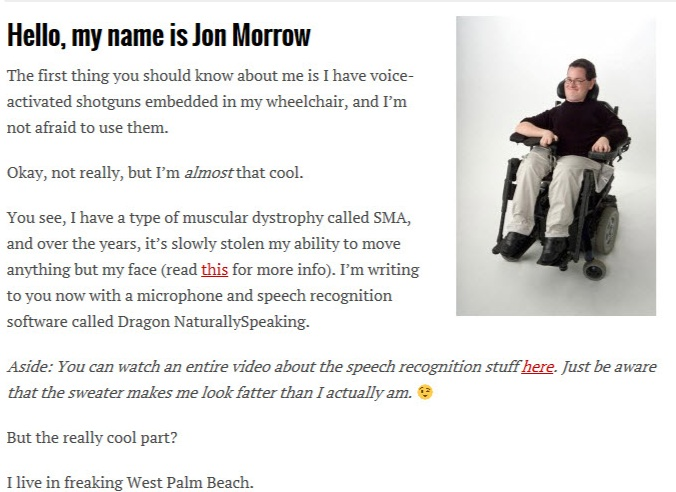
When he decided to make marketing strategy a key focus of his blog, he knew that sharing the lessons that he learned when building his blog and former businesses would attract a lot of readers.
However, he also knew that he could get even more fans and potential customers by teaching people how to implement the online marketing strategy that he used to growth hack his companies to these huge revenues in such a short time.
One tactic he uses often is breaking down a marketing tactic step-by-step with screenshots, results, and detailed how-tos.
Super-specific instructions like this are rare in any industry. If you can take people by the hand from A to B, that’s when you’ll build a loyal following.
What’s more, Jon often brings on guests to share their best tactics in the same manner so that you can learn about other ways of online marketing as well, such as building client relationships, social media metrics, and email marketing.
One way to learn what it takes to create awesome content is to just look at Jon’s writing.
For example, look at this intro:
“There are lots of guides about how to make money blogging, but here’s what makes this one different:
I’ve taken three different blogs to over $1 million per year. In fact, the blog you’re reading right now has made a total of $6.7 million.”
Doesn’t the intro entice you to read more? Morrow creates a huge curiosity gap, and he immediately draws the reader in. He then engages the reader further with imagery, captivating headlines, and bullet points:
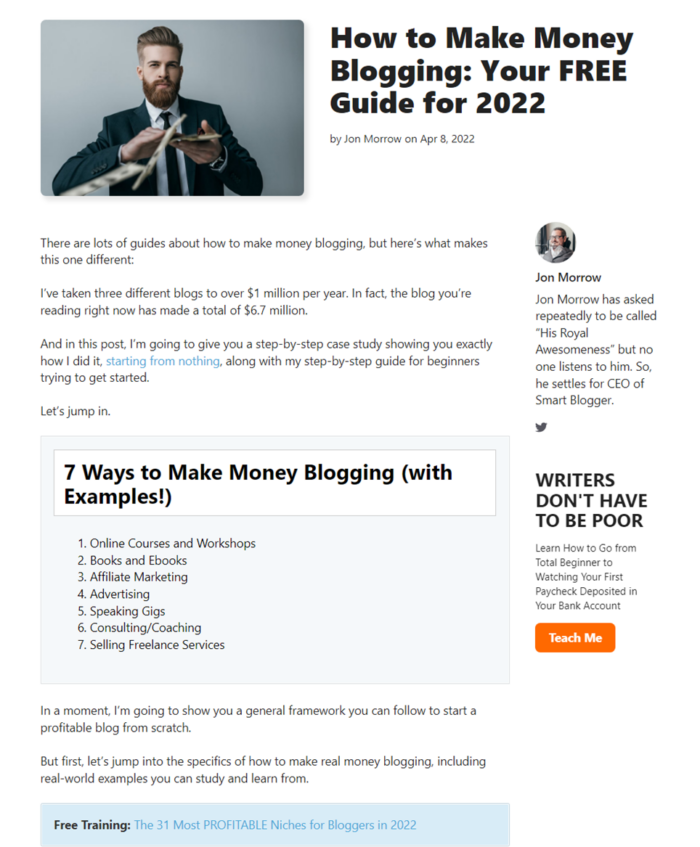
Another way to learn from him is by straight up reading his posts about, well, creating content. Three good articles to start with are:
- Demystifying Epic Content: How to Actually Create It (Not Just Jabber About How Important It Is)
- The Ultimate Guide to Writing Irresistible Subheads
- 20 Rules for Writing So Crystal Clear Even Your Dumbest Relative Will Understand
Why Content Marketing?
Why do you need content marketing? Because content marketing is SEO.
According to Google, content is one of the top two ranking factors. The more amazing content you create, the higher the chance you have of bringing in new traffic and leads from organic search.
If you’re looking to start an SEO marketing strategy, you need to produce content. The only way that people can discover your company from organic search (from a non-branded search) is through content.
For example, if you are a law firm without a strong brand presence, you need content that users are searching for to drive traffic.
You could publish an article on “Top 10 Things to Know When Getting in a Car Crash.” Blog content like this can drive inbound traffic, but how often should you post?
According to HubSpot, the amount of content you should publish every week depends on the size of your company and your aims. For example, a small company should post up to four new blogs a week for organic traffic, while a larger company would post four-five new and updated posts a week.
On the contrary, if you wanted to build brand awareness, you’d post fewer weekly blogs:
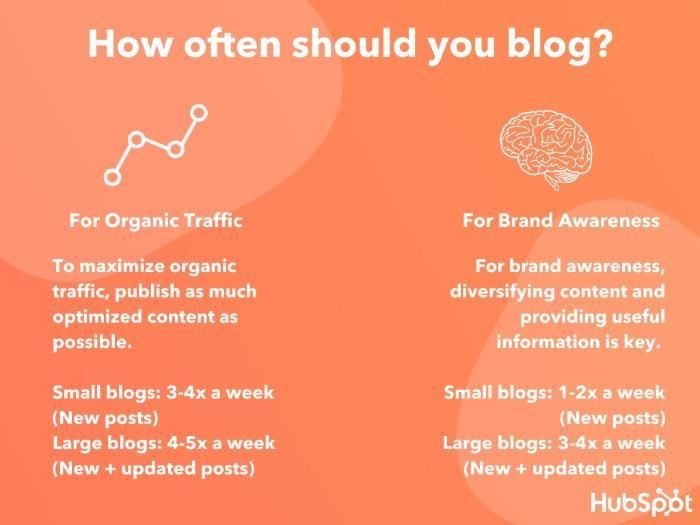
The more blog-based content you have, the more indexed pages on Google you have. Combine the two, and you have a lot of chances to get someone to visit your site.
Content marketing is the key to powerful SEO.
Sure, you can optimize your product pages and your homepage, but that won’t bring in traffic that doesn’t already know you.
Content marketing is the key to bringing in new visitors who haven’t heard of you!
Plus, the ROI of content marketing is massive:
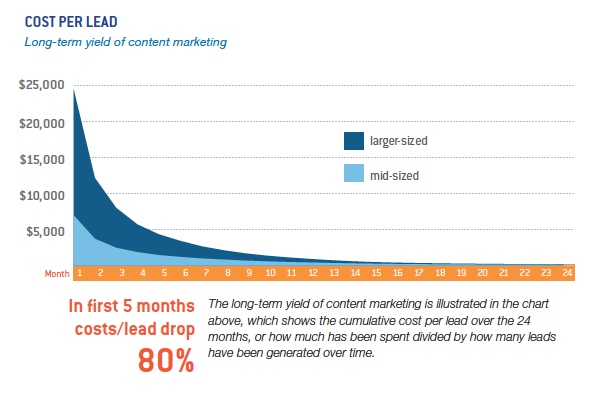
In the first few months, costs per lead can drop by 80%.
While content marketing isn’t an overnight success like PPC might be, no other tactic can match its long-term viability; content marketing is still one of the top tasks for the majority of businesses trying to generate more customers and sales.
Results might take a few months, but costs are overall much cheaper than paying for customer acquisition.
If you haven’t already, it’s about time you hopped aboard the content marketing train. What if you don’t want to blog, though? Well, you don’t have to.
Hubspot’s latest State of Inbound Marketing report shows social media is dominating online marketing, with website content/blogging not far behind, swiftly followed by email marketing.
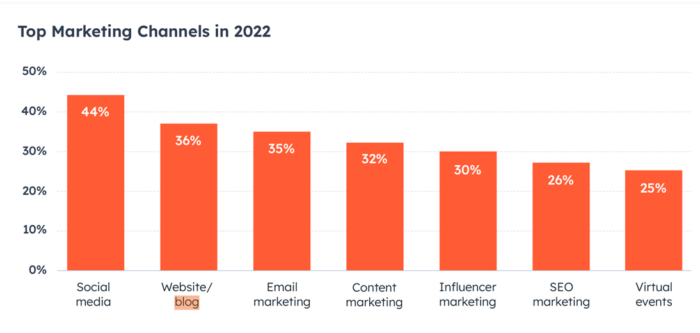
As you can see, content comes in many more forms than writing, including SEO and influencer marketing, blogs, virtual events, and videos.
For example, Daisy Jing grew Banish, her Shopify store, to earn $3 million in annual revenue by creating informative YouTube videos about acne.
If your strength isn’t blogging or writing, or if they simply aren’t a great fit for your business model, don’t stress about it.
As long as you are creating some form of unbranded content that users need, it’s likely you can find success.
For example, can you develop videos to upload to YouTube? I currently create videos on the top marketing struggles or trends in my niche:
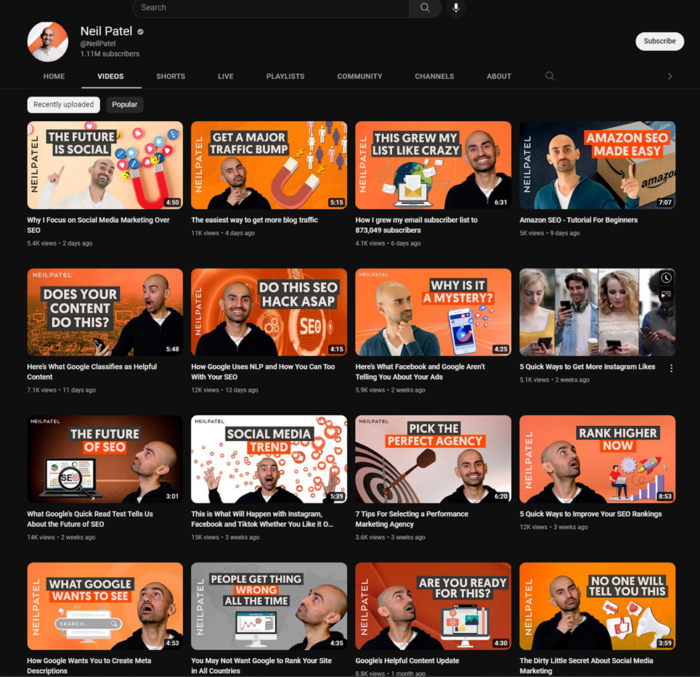
These videos serve as a form of content that can help me rank on Google searches while also providing valuable content on YouTube searches.
As always, this content serves a few major purposes for my company:
- Building brand awareness: By spreading my content and my name with tons of videos, people start to recognize my brand.
- Developing credibility and social proof: Posting informative, data-rich videos shows that I am a thought leader in my space, giving me instant credibility.
- Driving traffic and sales: I produce all of my videos with ROI in mind.
However, what if you don’t have the resources or time to create video-based content?
Try building a blog that focuses on photos like Pura Vida Bracelets does:
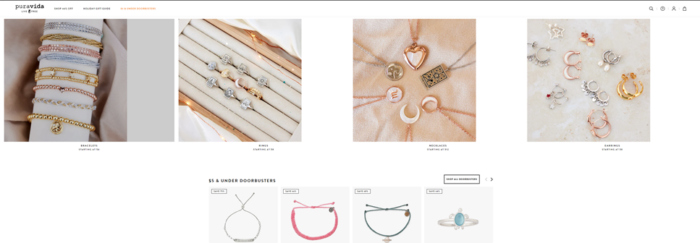
Their company sells bracelets with a charitable purpose, so blogging doesn’t really fit their niche.
Nobody wants to read about bracelets. They want photos of the bracelets and downloadable, lifestyle-based content.
Pura Vida meets these needs perfectly.
Blogging isn’t for everyone or every business. You simply need to find your content niche and start producing that content ASAP.
If you want to know more about other ways of creating content, take a look at my content marketing guide.
Content Mapping By Customer Journey
One lingering question you may have is this:
How does content help to drive sales and bring in new customers?
Well, that answer is complicated, but the best way to summarize it is through a customer journey.
Let me explain:
When someone visits your site or interacts with your brand on social media for the first time, there is little chance that they choose to buy from you.
Why? Because they don’t know who you are!
Would you Google search for “shoes” and buy the first pair you saw? You probably wouldn’t.
Customers buy in a logical manner, following a specific journey from awareness to decisions. HubSpot calls this the buyer’s journey:
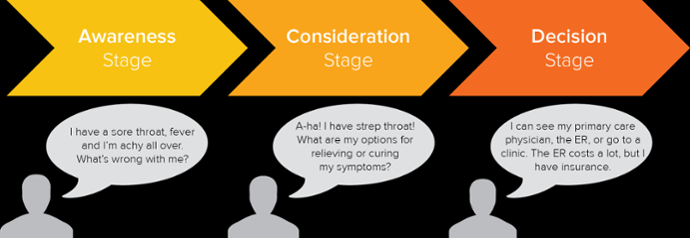
Customers move in progressive stages where they become aware of their problems, assess possible solutions, and then come to a decision.
This means that your content marketing efforts have to align with this journey. If you offer a user a lead magnet that requires them to give you their information in the awareness stage, you’ll simply scare them off.
They don’t know your brand, so how can you expect them to give you their details? You haven’t built trust and credibility yet. The relationship isn’t there.
However, if you ask for their email or contact details in the consideration stage, you’re right on track! They are brand aware and want high-value content.
Mapping your content to the customer journey means aligning your content efforts with each stage.
In stage one, the consumer is aware of their problem and need to fix it. As a content creator, you want to offer materials that attract these buyers, like:
- How-tos
- Infographics
- Press releases
- Social media
In the second stage, engagement, the prospect wants to evaluate products and see how they compare to others. You can do this through:
- Buying guides
- Case studies
- Explainer videos
- Benchmark reports
The third stage is conversion. Some ideas for this phrase include:
- Pricing pages
- Pitch decks
- Spec sheets
- Comparison pages
The final stage is retention. Once you’ve got your customer to commit to buy, you want to retain them through:
- Help articles
- Updates
- Announcements
- Surveys/polls
If you need more ideas, here is a checklist of content types for each stage of the funnel.
All that leads to one question, though: How do you understand your buyer’s journey better and know what content to serve your prospects?One way is by building audience personas and giving your personas individual names like John, Mary, Timothy, or Jane.
Naming your personas, however, is only the first step in identifying who these individuals and business owners are. Next, you’ve got to give them demographics and a background: how old they are, where they came from, where they’d like to travel, what their occupation is, etc. Use the raw data from whatever source you have access to – such as surveys, keyword and search term analytics, and forum threads.
When designing personas, include whether this persona represents your primary or secondary audiences. Also, include the persona’s goals and how he or she might meet those goals. That information shows you how to reach and persuade your audience effectively.
Developing a persona can be as simple as filling in the blanks of a template. Just remember that the reason that you’re doing this is to help you convey your message better and to answer your audience’s questions more clearly.
You can send a survey, questionnaire or, directly ask for input via your email autoresponder (Aweber, Getresponse, etc.),
When you receive feedback from your target audience, evaluate it against the details of the persona you developed. Then, incorporate the persona into your marketing strategy. Your marketing campaign will yield a higher return, as a result of this process.
Content Publishing and Syndication
Once you’ve created content, the next step is to publish that content and syndicate it on as many platforms and sites as you can.
Content is great on its own, but it never hurts to boost it on social media or share it with other content creators.
This helps you drive more traffic and links to your content, increasing your chances of ranking and getting leads.
The most common step is to share content across social media platforms.
For example, using a tool like Buffer, you can schedule a new content piece to publish on every single social platform that your business is connected to:
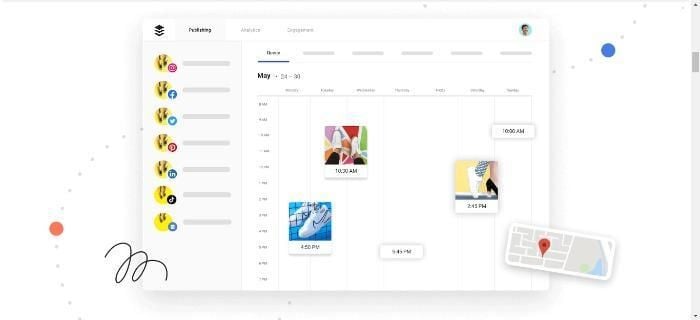
I use this strategy to share every new blog post on social and to promote all of my latest pieces:
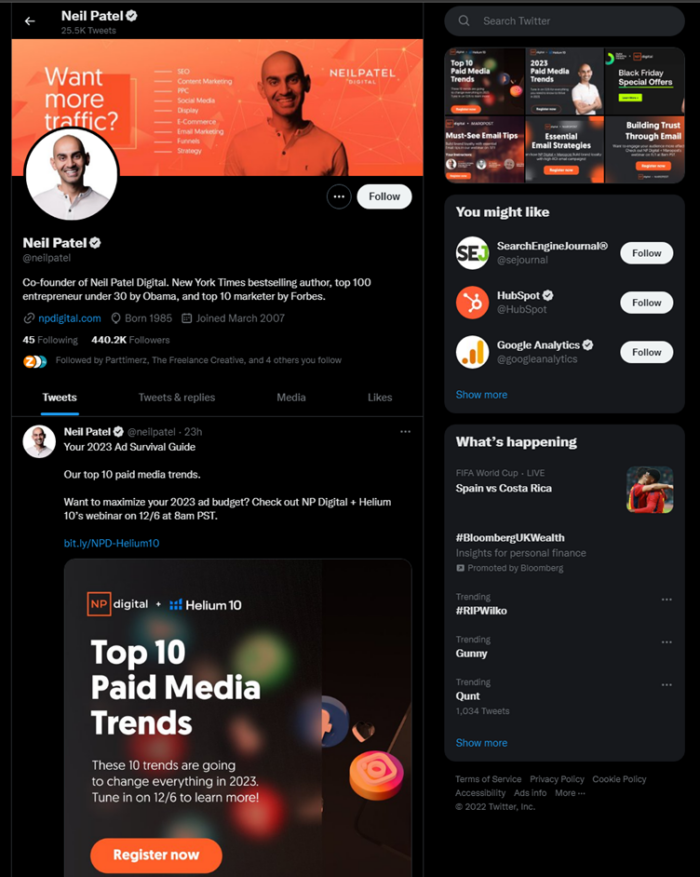
Syndication is another tactic to help expose your content to as many people as possible.
Content syndication is simply the process of publishing your content (blogs, videos, etc.) to third-party sites that will re-publish it on their own.
Do you want to syndicate your content and get more traffic? Check out my guide here:
Social Media Marketing
Social media is a beast. This industry is gigantic, and according to recent research from the Digital 2022 July Global Statshot Report, there are 4.7 billion active social media users.

By now, there are a ton of social media networks out there.
This topic deserves a whole guide on its own, but if you want to be successful with social media (and you’ll HAVE to in the long run), your best bet for a one-stop shop is Gary Vaynerchuk.
Gary is firing on all cylinders and platforms. He has written five New York Times bestsellers (two of which solely focus on how to use social media for your business), and he runs one of the biggest media agencies around.
He’s successful on Twitter because he’s witty and engages with lots of people individually. He has managed to amass 3.1 million followers on the platform.
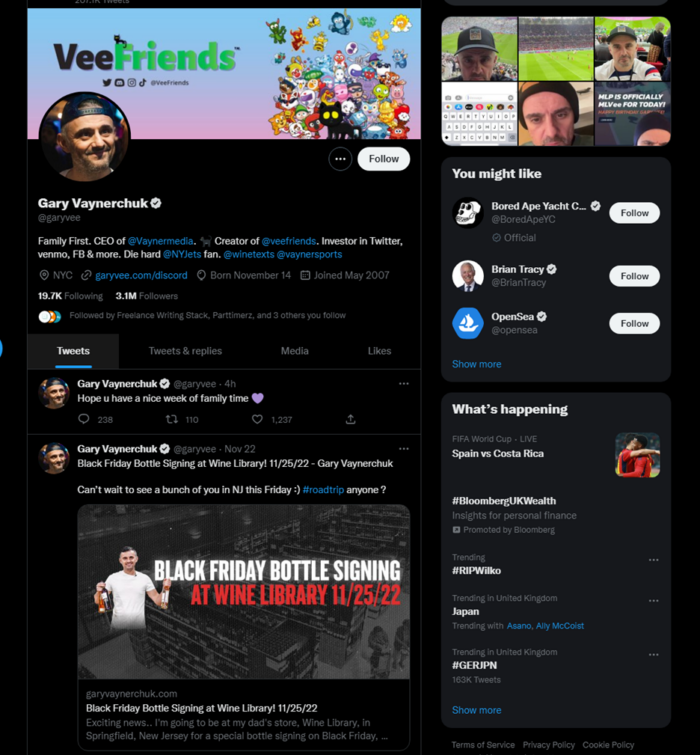
On YouTube, he dominates with his #askgaryvee show, which he publishes frequently now. It’s attracted 4.04 million subscribers and covers online marketing, entrepreneurship, content creation, and NFTs.
Then, there’s his Facebook page with over 5.5 million followers and his Pinterest board with 110.5k followers. Finally, of course, he couldn’t miss out on Instagram. He’s grabbed another 10 million followers there.
Several million people follow his every move. If you watch him closely, you can learn the art of social media from him.
One of the biggest takeaways from Gary is that content follows context.
He says, “Content is king, but context is god.” What he means is that if you don’t respect the context of each individual social media platform, you’re bound to lose.
For example, I could have posted this blog post as a Facebook status update, but would that make any sense? No!
No one consumes long-form content on Facebook. That’s what blogs and YouTube are for.
Instead of seeing social media as a distribution channel where you push out the content that you created on one platform to all of the others, try to tell stories that match the context of each platform.
Since Gary is also a speaker, you can learn a ton about social media by watching his talks on YouTube.
However, Gary’s not the only social media wizard out there, so here are a few other resources to help you learn how to thrive on various social media platforms:
- Facebook Marketing: A Comprehensive Guide for Beginners
- 22 Ways to Make Your Facebook Ads Better
- Instagram Marketing Guide: 10 Tips that Actually Work
- 12 Powerful Twitter Marketing Tips (That Actually Work)
How Brands Are Using Instagram
Instagram is among one of the most popular social networks in the world, with 1.39 billion active users.
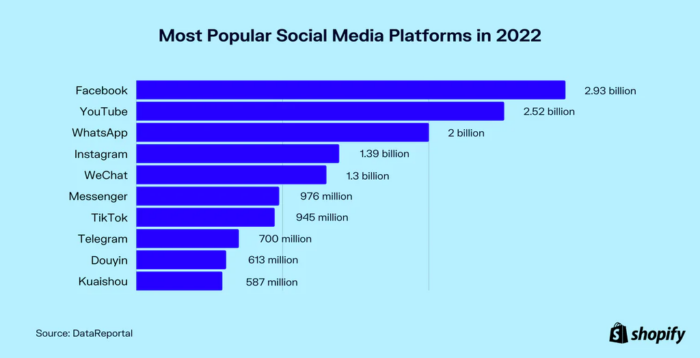
Despite TikTok’s growing user numbers, Instagram surpasses it, and companies are getting aboard.
Brands are tapping into this growth to showcase their products and drive sales.
One of my favorite examples of brand success on Instagram is HubSpot.
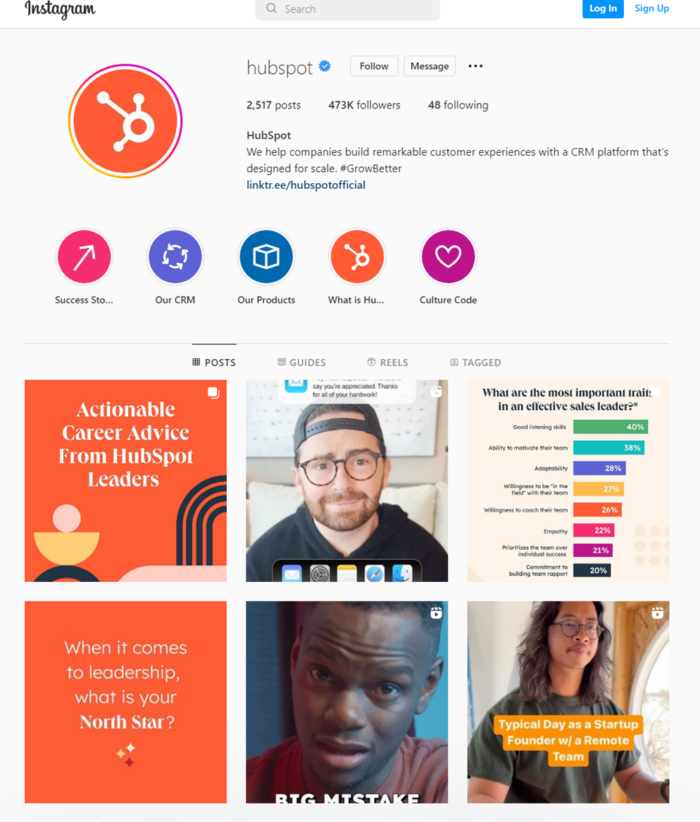
HubSpot excels at producing online marketing and entrepreneur-related content for its followers.
Instagram is, of course, focused on visuals; HubSpot taps into this by producing beautiful images and video-related content with marketing tips.
It perfectly combines inspiration with tactical tips for a great, well-rounded Instagram account.
Do you want to get started with Instagram marketing? Create an Instagram for your business and start posting content related to your niche.
If you need more tips, here are a few articles to get you going:
- Beginner’s Guide: How to Build a Killer Instagram Following and Increase Your Sales
- 15 Ways to Get More Instagram Followers
How Brands Are Using Snapchat
Snapchat is another popular social network channel that can be huge for building brand awareness.
While it’s not as popular as Facebook or Instagram, it still works to create a following that engages with your content.
Currently, brands are finding huge success by appealing to new audiences through online marketing. MTV is an excellent example of this. When it joined Snapchat, it decided to target Gen Z (people born between 1997-2012) viewers.
What did MTV do to achieve this? It put a new twist on an existing show. Long-term show Cribs was given a new look with an energetic pace and featuring celebs that are likely to appeal to a younger audience.
The show also provides behind-the-scenes footage to further engage the younger audience, along with the development of an online community.
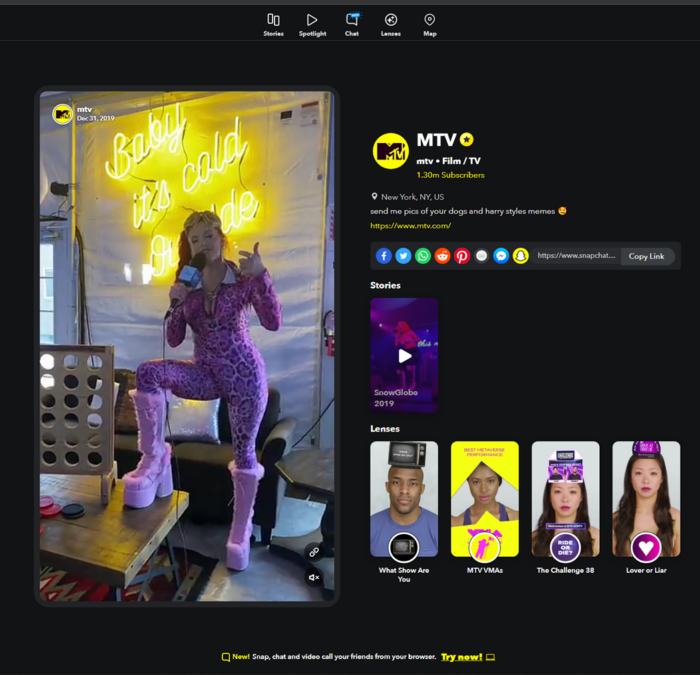
Snapchat is great because the options are so diverse. You can post anything you want, just like you can on Instagram.
Do you want to learn more about Snapchat marketing? Follow these tutorials:
- New Kid Alert: How to Drive Sales to Your Business Using Snapchat
- The 4 Principles of Successful Snapchat Marketing
Recent Social Media Trends to Be Aware Of
As consumer behavior changes and technology expands, trends are always shifting.
Current trends show us that social media marketing is changing fast. While social platforms have always been amazing for organically reaching customers (and for free), that is slowly becoming less of a reality.
While Facebook once was the king of organic reach, research shows it’s on the decline.
The organic reach levels are nearly at rock bottom compared to five or six years ago.
Why? The social media landscape is becoming a ‘pay to play’ sector.
As social media platforms continue to grow, they realize that ad revenue is their number one money maker, and simply giving away free organic visits doesn’t help their cause.
With that in mind, you need to have a combination of both organic and paid posts on social media to find the most success in your marketing plan.
Other social media trends are:
- Short-form videos
- More social media communities (think Facebook Groups and similar)
- A growth in social commerce
- An increase in social listening
- Local targeting
- Personalization
- User-generated content and influencers remaining popular
Looking further ahead, Hootsuite predicts that ‘TikTok will take over the world’. It also anticipates the following trends:
- Photo-sharing app BeReal will dominate the sector
- Gifs will no longer be cool
- Closed captions will become the default on social media
According to Hootsuite, you’ll want to be on the lookout for more billionaires buying social media platforms, too.
Paid Social Advertising
All social platforms have their own forms of paid advertising. From Instagram to Facebook to Twitter, you can sponsor posts and even create powerful custom audiences.
On Facebook, advertising works in the display format. Here’s an example of an ad that I’ve run on Facebook:
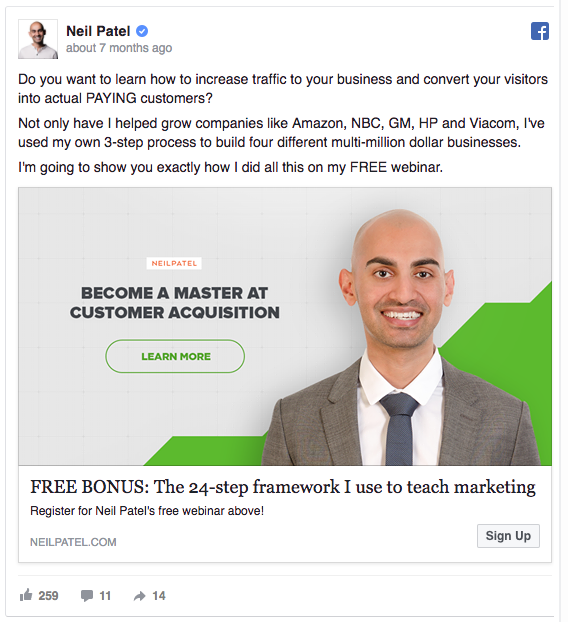
These ads show up directly in the news feed of the customers you’re targeting.
Facebook has some of the best audience-targeting options in the market. You can effectively target audiences by income, interests, job positions, and just about anything you can think of.
Here are a few articles to get you going with Facebook advertising:
- Facebook Advertising Made Simple: A Step-by-Step Guide
- Beginner’s Guide to Running Facebook Ads That Convert
On Twitter, running ads is a great way to boost your posts. I love running Twitter-based ads that boost my latest blog posts to get more traffic.
One of my favorite examples of a powerful Twitter ad comes from Hootsuite:

Using their content, they boost their posts to create ads for relevant, targeted audiences.
This allows them to reach a larger audience than their own following, bringing in more traffic, leads, and followers.
To get started on Twitter with advertising, I recommend reading this resource:
Lastly, LinkedIn is one of my favorite places to advertise and promote content. LinkedIn not only offers successful organic posting, but it also has a user base of high-level users.
It helps you reach people who are otherwise hard to reach, such as c-suite executives.
Content promotion and audience targeting are the keys to LinkedIn. Currently, one of the best ads I’ve seen on LinkedIn comes from Godaddy Australia, and it’s a fine piece of online marketing.
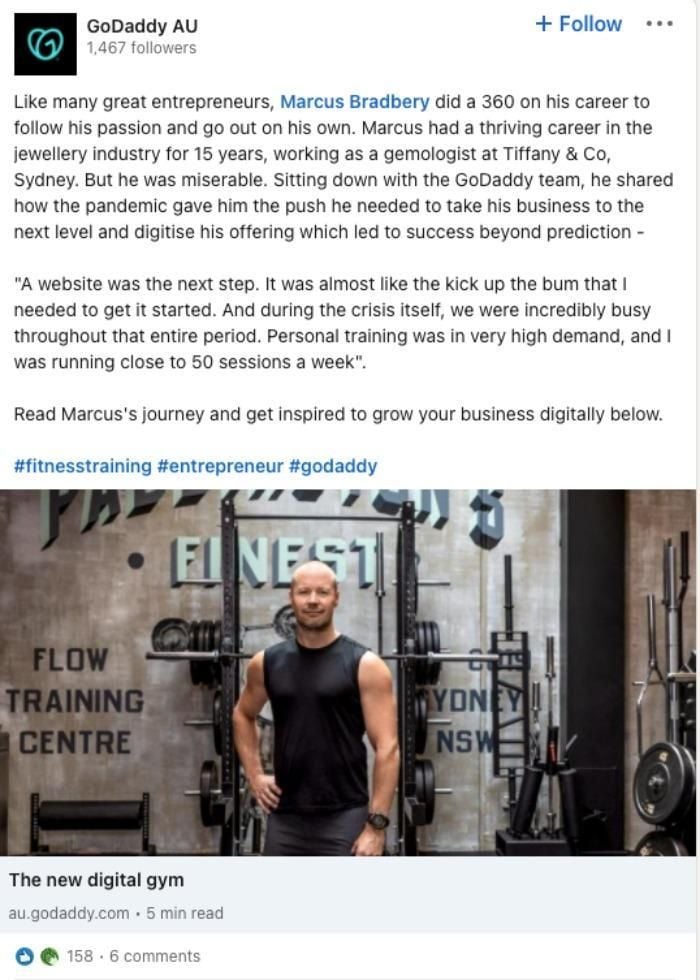
Rather than taking the obvious approach and promoting its web hosting service, GoDaddy chose to use an inspirational story from one of its customers.
This is an excellent example of doing things differently: you don’t always have to directly sell to your customers: A story that inspires can be enough to get your prospect to want to find out more.
LinkedIn, just like Facebook, has diverse audience targeting options and ad options.
Get started today by following this tutorial:
Pay-Per-Click Advertising
Pay-per-click advertising is exactly what the name suggests. You pay for each click that you receive on an ad that you create.
Sounds similar to search engine marketing, doesn’t it? That’s because it is. However, while SEM is only one type of PPC advertising (and a very special one), many platforms offer to show your ads to their audiences with PPC, too.
Twitter does it, LinkedIn does it, YouTube does it, and Instagram offers them, too. However, the most popular platforms for PPC advertising are Google Ads and Facebook.
On Facebook, you create Meta Ads that look just like a Facebook status update.
Then, you can pick a specific audience. For example, you could target women in Austin, Texas, between the ages of 32 and 45, who like Jon Bon Jovi. Yes, it’s that specific.
Last, you set a budget based on how much you’re willing to pay per click.
Facebook then serves your ad to your audience in their Facebook news feeds on their desktop computers or their mobile phones.
You can also place ads in the sidebar.
When people click on your ad, Facebook redirects them to your page, which can be part of your Facebook fan page or any URL you define.
This way, you can get people to buy your product, read your content, or sign up for a webinar.
Stock photo company Shutterfly knows how to run a great online marketing ad, as you can see from the example below.
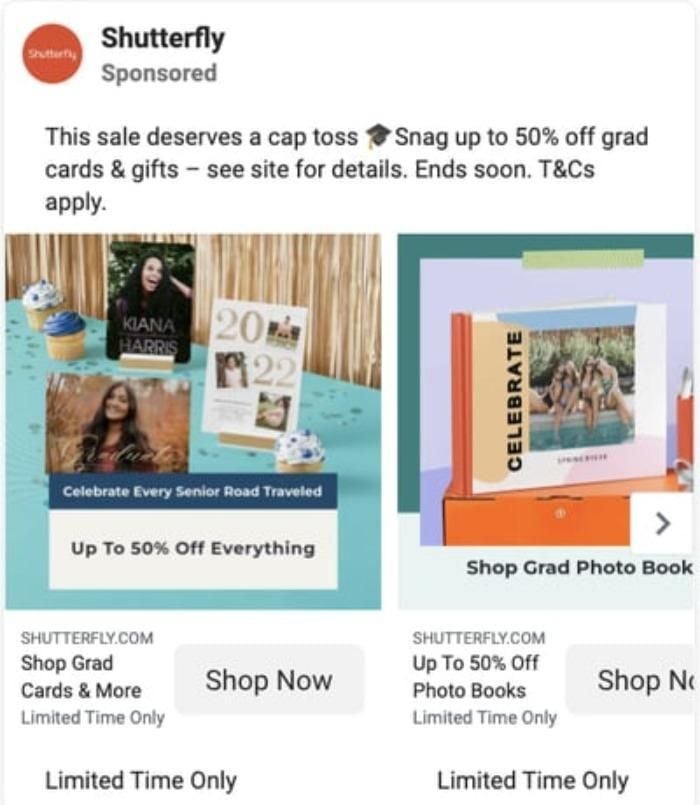
Shutterfly takes the ‘why advertise one product when you can promote multiple items?’ approach to its Facebook advertising and does it well.
In its advert, Shutterfly shows the 50 percent discount buyers can get, which automatically captures the eye. Additionally, Shutterfly targets the ad at a specific demographic: the kind of person who enjoys taking photographs.
That’s not all, though.
Shuttefly gives a time-limited offer, encouraging consumers to click through sooner rather than later. Finally, the ad finishes up with a CTA with ‘shop now’ in bold.
What’s good about PPC is that it integrates seamlessly into the flow of its respective social media platform.
Ever since marketers first started advertising heavily, consumers tried to avoid it.
Why?
Because in 99 percent of all cases, it’s not relevant to them.
What college kid needs to see a billboard about adult diapers? None!
With PPC, marketers can be sneakier; we need to be.
The ads show up as part of the natural ‘just scrolling through my Facebook feed’ process and are much less obvious.
Plus, thanks to the specific targeting, you can ensure that relevant potential customers actually see your ads.
A prime online resource is AdEspresso.

It helps you optimize your online marketing efforts by allowing you to:
- Create A/B split testing
- Write ads across three platforms (Facebook, Instagram, and Google Ads with the grid composer for bulk ad creation
- Automatic page post promotion
- Create dynamic ads
Subscriptions to AdEspresso start at $49 a month with a spend limit of $1,000 a month. To get started, you can sign up for a 14-day free trial.
Not sure where to start with Facebook ads? Don’t worry. AdExpresso provides a detailed guide and an eBook to talk you through it.
Here are some other good articles and resources to help you start your first Facebook Ad campaign:
Everything That You Need to Know About Google Ads
In pay per click (PPC) advertising, Google Ads is the most popular platform to conduct business on.
Recent search ad sales for Google Ads reached $40.69 billion, and has a 28.6 percent share of the total digital revenue in the United States.
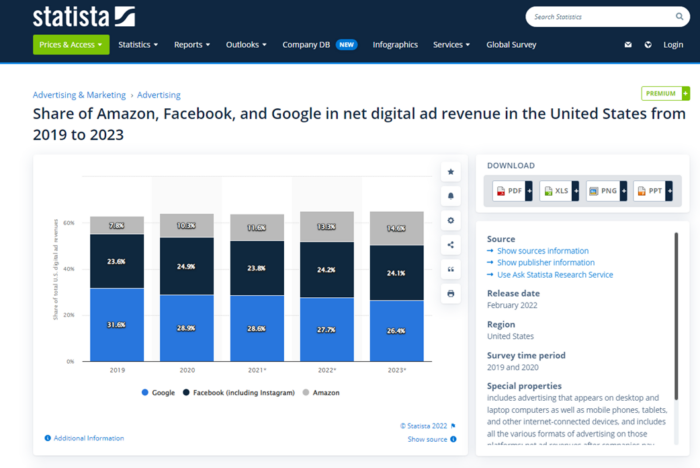
Second to Google Ads is Facebook, but they are still behind by a large margin.
Perhaps you’re wondering why Google Ads dominates the PPC space?
It’s simple: it’s the best search engine in the world and the most popular, with a market share of 83 percent of the global search market.
According to the Statista figures I’ve mentioned above, Bing trails far behind with a market share of nine percent. Nothing else even comes close to the power and user base of Google.
That means that everyone wants to advertise on Google to capture these billions of users daily.
Advertising on other search networks can be great, but the user bases are much smaller, making it harder to reach your target market.
With that in mind, Google Ads is one of the best places (if not the best place) to focus your PPC strategy on.
How does it work?
Google Ads operates on a bidding-based system. For example, on the search network, you bid on different keywords against multiple other advertisers who are looking to rank first.
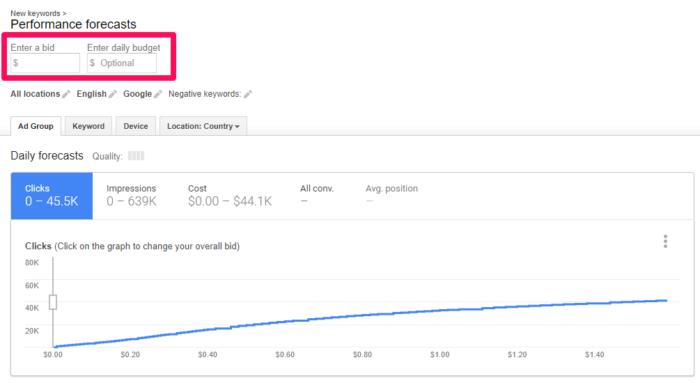
Keywords can cost anywhere from ~$1 to $500+ depending on your industry. Keywords will cost whatever advertisers are willing to pay for them.
For example, a keyword for a law firm might cost $100 per click because their end profit from a single case could be thousands of dollars. That means that they are willing to bid that high because their profits can justify it.
On the other hand, cheaper products will result in cheaper costs per click.
So, where can you advertise?
Google Ads consists of multiple different advertising options. Here, I detail them for you and explain what works best for most businesses:
Google Ads Search Network
The Google Ads search network allows all advertisers to produce text-based ads targeting a specific keyword to show up in search results. For example, when you see results at the top of a search result marked “Ad,” that’s the search network:
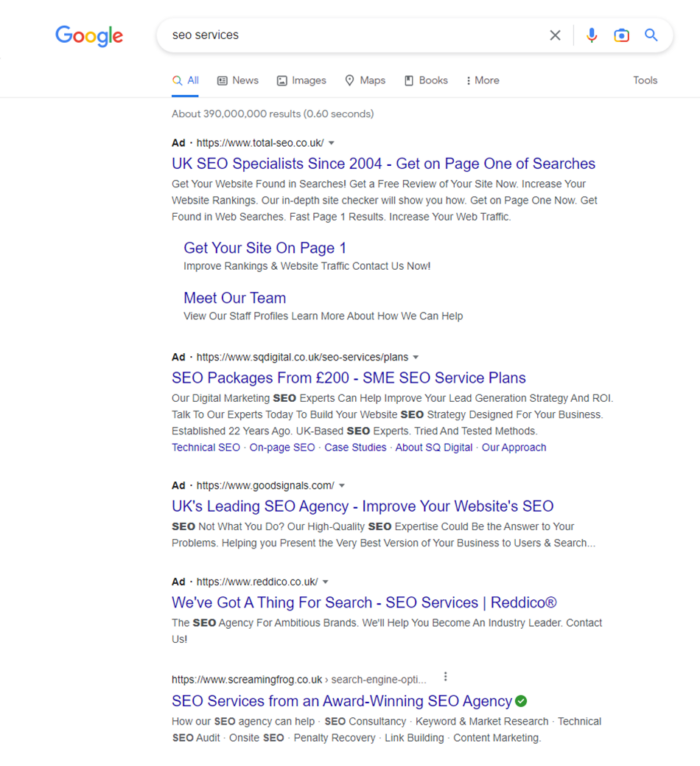
The search network is one of the most powerful PPC advertising platforms the world has ever seen.
Why? It’s due to one single factor:
User intent.
Think about it this way:
On Facebook, people aren’t browsing their news feeds to see ads, right? They are on Facebook to engage with their friends and family and maybe to see some news on the side.
However, the goal of it isn’t to find products or services. It’s social media. It’s about interaction.
The search network on Google Ads is a whole different animal. People are literally searching for things based on specific keywords to find solutions.
For example, think about a search for “plumber near me.” What does that keyword signify?
That user is trying to find plumbing services ASAP.
That’s intent to buy directly from a single search. Where platforms like Facebook can take multiple ads and remarketing campaigns to convert a prospect, the search network can convert someone from a single keyword search.
It’s one of the main reasons why people love advertising on Google’s search network.
Google’s Display Network
Google’s display network is a key tool for marketing online. By placing ads on websites, apps, and videos across the internet, businesses can reach a vast audience of potential customers.
It’s another powerhouse of advertising that Google offers to every advertiser on their platform.
The display network taps into Google-approved sites, allowing advertisers to show image-based advertisements on related sites by topic and keyword context.
For example, ads like these are from the display network:

These ads show up on related sites or sites that you frequently browse that use AdSense.
AdSense is sort of the reverse of the Amazon display network.
It’s an online marketing program that allows website owners to place targeted ads on their sites. The program is free to join, and it’s easy to set up. Once you’ve signed up, you simply add a few lines of code to your site. Google then serves the ads. When someone clicks on one of the ads, you earn a commission.
They’re often sitting above the website or on the sides of the web page, and they’re a great way to capture new users.
On top of that, the display network offers another powerful feature: it’s called remarketing and I’ll discuss it next.
Remarketing
Remarketing is the process of bringing back users who have previously engaged with your company.
If you have remarketing enabled, you could use ads to target users who landed on your website but didn’t convert.
This allows you to bring those users back for a second or third or fourth shot at buying from you.
Remarketing is vital because most of your prospects aren’t yet ready to buy from you.
One of my favorite examples of a powerful remarketing ad on the display network is from Gap.
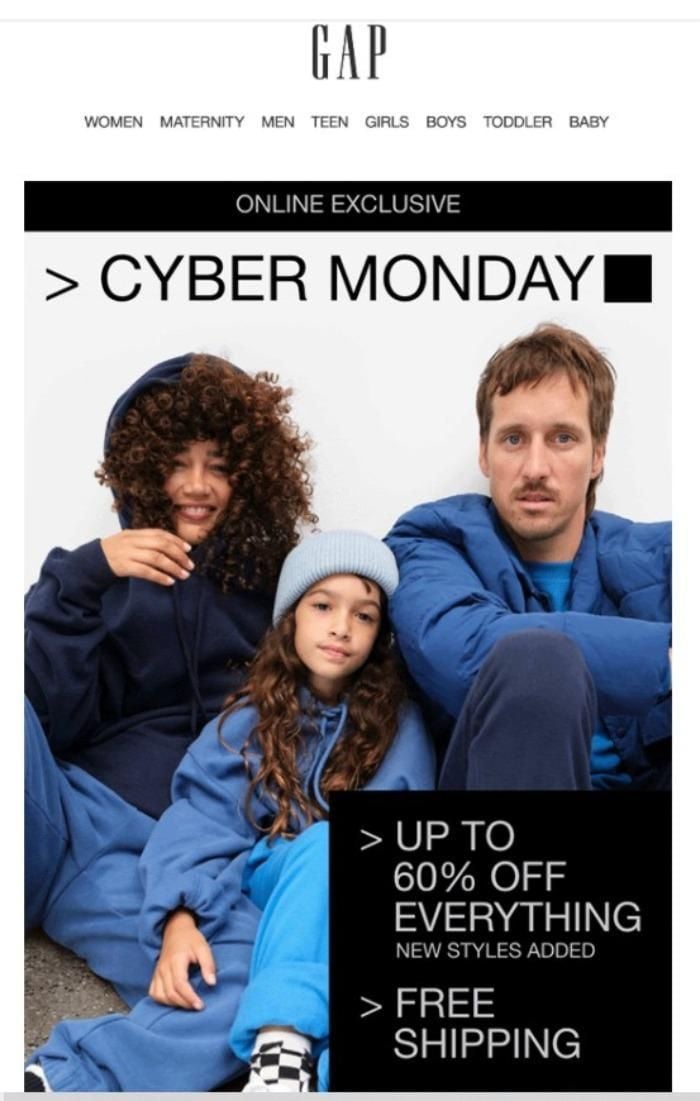
It’s a basic advert, but it targets a former customer by promoting the sale. As you can see, there’s a 60 percent discount on offer, free shipping, and it’s an exclusive online deal. Those are three reasons right there to click-through.
You can use the Google Ads display network for remarketing, and anyone can set it up.
If you want to find out more, here are a few key resources for you.
- Google Ads Made Simple: A Step-by-Step Guide
- The Entrepreneur’s Guide to Google Ads
- I Increased Sales When I Made this One Google Ads Change
- Unbelievably Devastating Mistakes People Make with Google Ads
Read those posts, and you will be on your way to dominating Google Ads and driving sales, like you’ve never imagined.
Affiliate Marketing
You can’t spell affiliate marketing without Pat Flynn. Well, you actually can, but you shouldn’t learn it without him.
When Pat first launched Smart Passive Income, he was just starting to get familiar with selling informational products online. His first product was Green Exam Academy. It’s a course that he created to help people pass the LEEDs exam for architects, and it sold well.
He wanted to learn more about the concept of passive income, which is where you earn money without actively working for it (after an insane amount of work up-front, of course).
If you’re familiar with Flynn’s site, you know that affiliate marketing is his single biggest source of income.
What exactly is affiliate marketing, though? Let me explain.
Imagine that you know a great pizza place. You know the owner, Luigi, and you go there all the time.
Naturally, you tell your friends about it.
When your friend Tim goes to the pizza place, he mentions that you told him about the pizza parlor and proceeds to buy four pizzas for his friends.
The next time you come back, Luigi says, “Dude, your friend bought four pizzas because of you, and that’s the biggest order I had all week! Thanks, man! Here’s $5 for referring him.”
Ka-ching!
You’ve just made your first affiliate marketing sale.
Except, it doesn’t usually happen in real life like this, especially because a pizza place whose biggest order in a week is four pizzas won’t be around for very long.
However, luckily for you, there’s a place where it happens all the time: online.
Amazon is a prime example (pun intended).
When you sign up for their affiliate program, you can generate a special link for every single product page that they have.
You can then put that link on your blog, for example, or send it to friends you want to recommend that product to. If they click your link and buy the product, you get a small commission from Amazon for referring that customer.
Interested in affiliate marketing? I’ve created some of best resources online about affiliate marketing.Here are some great starting points:
- How to Start A Blog That Makes You Money
- 6 Advanced Affiliate Marketing Strategies to Try
- How to Boost Your Growth With Affiliate Marketing
Getting Paid For Affiliate Marketing
Now that you have a basic understanding of how affiliate marketing works, how do you get paid?
As I explained in the pizza example, you usually get paid every time your referral leads to a sale.
One of the most popular ways to drive affiliate sales and get paid is by blogging or creating content around those products.
NerdWallet is a great example of a business that thrives off of affiliate marketing:
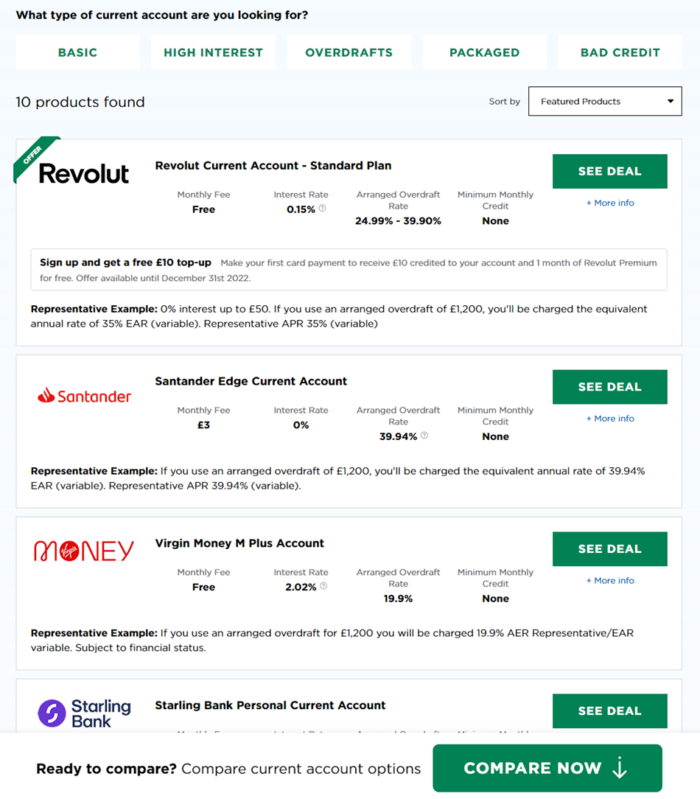
They focus on personal finance, so they review different credit cards and help users find the best cards for their businesses or lifestyles.
Here’s the kicker: they make money every time someone signs up for a credit card using their site.
For example, if someone clicks on the Revolut card and signs up, NerdWallet gets a portion of the revenue for their efforts.
Do you want to take your affiliate marketing to the next level? Follow this guide to add affiliate marketing to your online marketing game plan today:
Email Marketing
Lots of articles online show you “how to write better emails” or “how to pitch anything.” But, before you can send those emails, you first need the list of people to send them to.
That’s what email marketing is all about: Directly communicating with your audience and customers.
According to Mailmunch, 60 percent of the online marketers it questioned said email outperformed social media in terms of getting traffic and conversions. Plus, email is a good, long-term method of building relationships, nurturing prospects, and guiding them through the customer journey.
There’s an easy explanation why this is: Think back to the last time you changed your phone number. It probably wasn’t that long ago, right?
Now, do you remember the last time that you changed your email? You probably don’t.
Changing your email is an absolute pain, so people rarely change them. That makes an email address a valuable piece of contact information.
Want to learn more about email marketing? Follow the links below:
- How to Grow Email Subscribers to Five Figures and Beyond
- How to Craft Lead Magnets Your Customers Can’t Ignore
- How to Use a Giveaway to Accelerate the Growth of Your Email List
How Email is Evolving
Email marketing has evolved over time, but it continues to be one of the most rewarding online marketing strategies.
Don’t believe me? Then look at these stats.
According to Hubspot,
- 77 percent of marketers are seeing an increase in email engagement.
- 64 percent of B2B marketers say email marketing helped them reach their business goals
- B2B marketers say new product and feature announcements have the highest click-through rates.
Email marketing is critical for any business to develop loyal customers and drive sales without spending a dime on advertising. However, you can only create effective online marketing campaigns if you keep up with the trends.
What’s looking hot for the future? Well, it depends on who you listen to, but these feature in most trend lists:
- Hyper personalization
- User-generated content
- Interactive emails
- AI
There’s also perennial trends to consider, like:
- Mobile marketing
- Storytelling
- Segmentation
- Personalization
Just a quick word on personalization and segmentation:
Personalization
You need to personalize emails to break through the flood of emails an average person gets. That means everything from using the customer’s name to referencing their history or interests. Personalized emails deliver much higher open and conversion rates when you compare them to boring, templated emails:
For a few more in-depth examples, read my article ‘15 Email Personalization Techniques That Work.’
Segmentation
Segmentation focuses on splitting up your customer email list into specific groups, allowing you to target them with much more specific content.
For example, let’s say that you have customers who have purchased basketball shoes and customers who have purchased soccer shoes.
Sending a generic email about a coupon likely won’t generate sales. However, splitting those groups into two email lists and sending specific basketball and soccer shoe coupons will skyrocket engagement.
For example, look at this email from the owner of Video Fruit, Bryan Harris who was looking to validate his online course. To do this, he segmented his email list for users who downloaded content that was similar to his online course:
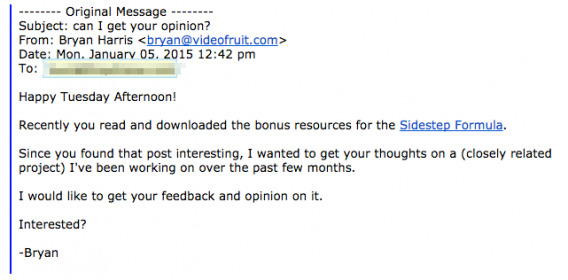
This customized, segmented email blast generated a 72% reply rate.
Making email marketing as specific as possible is going to help you drive better open rates, response rates, and conversions.
Do you want to learn more? Here’s my guide on how to use email segmentation to increase your conversion rate.
The Best Email and Online Marketing Tools
This article wouldn’t be complete without a quick roundup of some resources to get you started in your online marketing journey.
Below, I’ve listed some of the most popular mailing list management services. If you’ve got limited funds and are looking for some low budget strategies, I’ve got you covered there too with a list of free copywriting resources and tools.
A good email marketing tool can help you automate your efforts and consolidate your tools into one, saving time and money while improving productivity.
The most popular email marketing tool on the planet right now is MailChimp.
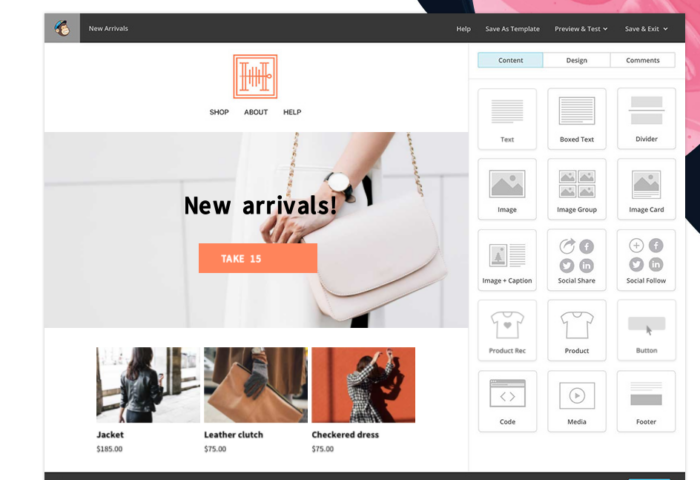
Their drag-and-drop builder allows you to create stunning email templates for any type of business.
You can do everything from scheduling email campaigns to automating, segmenting, and personalizing them, and more.
It’s safe to say that MailChimp is a one-stop-shop email marketing tool that can help your business save time.
Other amazing email marketing tools include Constant Contact, Drip, ConvertKit, AWeber, GetResponse, and ActiveCampaign.
As for the content creation side, there are plenty of free tools and resources available. Here’s a round-up of some of the best:
- Copyblogger’s Copywriting 101: This is the first free resource I recommend you start your copywriting journey with. You need to focus on building a solid foundation that can pave the way for more refined copywriting skills like headline hacking and creating conversion-inducing copy.
- ConversionXL Quick Course: This is the next great step in mastering copywriting skills. The truth is that 79% of people skim blog posts and long-form website content. People don’t like to read today. That’s why your website content needs to be punchy and direct. You need to deliver the message with as few words as possible, without skimping on the value. Peep Laja’s guide will help you do just that. You’ll learn how to simplify your writing while still providing the same message to convert more readers.
- HubSpot’s landing-page copy checklist: Landing pages are your chance to dazzle visitors with the value you can offer them, and to do that, you need copy that creates urgency, action, and desire. HubSpot’s checklist teaches you exactly how to do just that.
- CopyBlogger’s Magnetic Headlines Guide: Only 8 out of 10 people will read your headline, and on top of that, only 2 out of 10 will read your post. That’s where these magnetic headline tricks come into play. They help you beat those odds!
- De-jargonizer: Concerned you’re using too much jargon? Fear not! Just upload your document or copy text into this tool. Give it a moment and it highlights ‘jargon’ and gives your copy a score.
Marketing Online: Some Tips for Writing Amazing Copy and Creating Successful Campaigns
Sure, all this may seem daunting, but creating an online marketing plan and writing engaging content doesn’t have to be as challenging as it seems. Here are some tips and techniques to use:
Drip Campaigns
Drip email campaigns are the bread and butter of a successful email marketing game plan. They make use of automation to send follow-up emails to users who don’t respond.
For example, if a user doesn’t respond to email #1 about your offer, you can re-engage them with a second automated email in two days to remind them.
Similar to remarketing, they offer another chance for a user to convert.
One of my favorite examples of a drip campaign comes from Kapost. Here is the first email in their sequence:
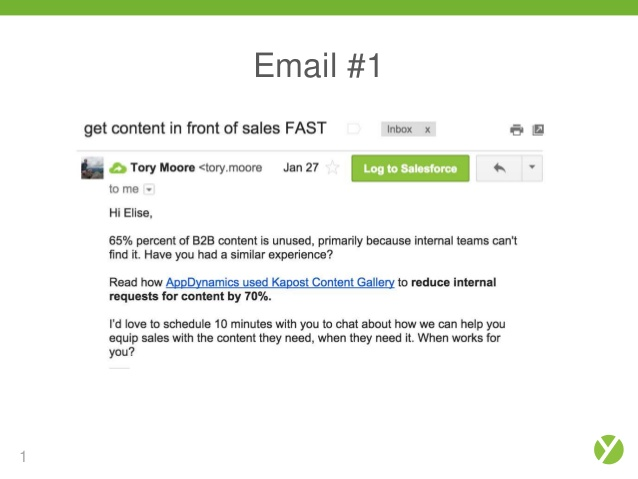
Later down the line, when the prospect isn’t responding, Kapost taps into personalization to re-engage the user:
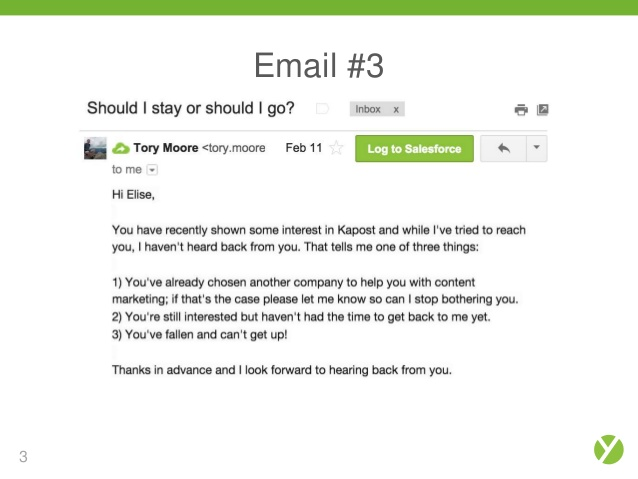
By referencing their interest in Kapost’s content, they are showing a deep level of understanding for the customer.
Drip campaigns should be a big part of your online email marketing efforts. If you’d like more details, here’s a guide:
Get started creating a powerful drip campaign today with this guide:
Now, here are some tips on crafting copy:
Use Persuasive Hacks
What factors influence your customers to say yes?
That’s what persuasion is all about and it’s always a challenge. Instead of struggling to convert your readers into customers, try leveraging successful persuasion hacks. Use these hacks to persuade and drive more visitors to your landing page.
Growth hacking is all about taking advantage of proven marketing campaign strategies to grow your business. There’s nothing fancy or trendy about it – it’s just marketing that works.
Online persuasion has everything to do with understanding your target customers and what they’re looking for. Once you’re sure about their needs, you can speak their language and convert them much more easily.
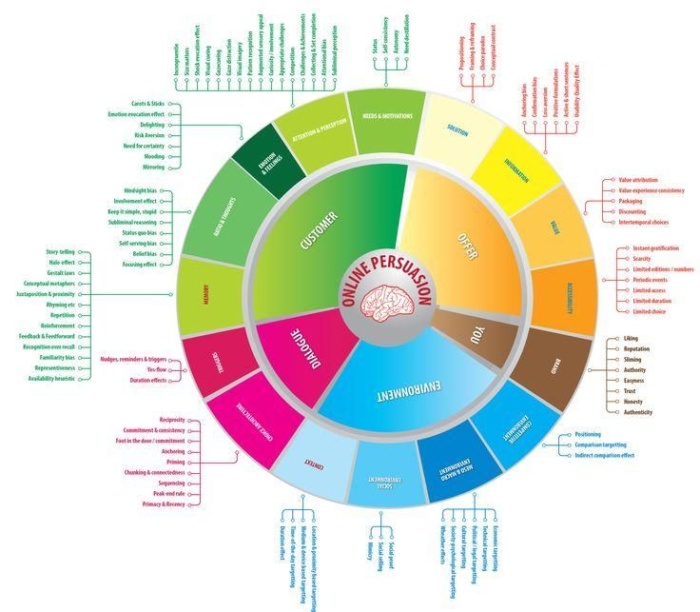
When influencing people, remember that reciprocity is crucial. In other words, give to your readers, without expectation of anything in return. This isn’t just New Age feel-good stuff – it’s science: when you give to others without expectation, it creates a feeling of indebtedness in them, making them more receptive to your eventual pitch.
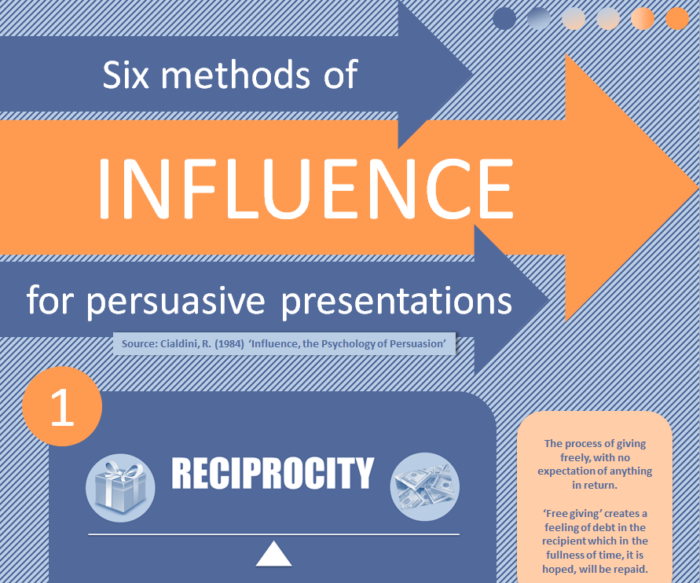
See also: 6 Psychological Triggers That Will Win and Influence Customers
Write Instant-Clarity Headlines
You might get 8 out of 10 people to read your headline, but only two will read further – less if your headline is sub-par. The headline is the key action driver for your content. It should be designed to persuade each of your readers to read the rest of your article.
WordPress has made it fairly easy for anyone to start a blog and write all day. Sounds great, right?
The downside of that lower barrier to entry is that users are overwhelmed and suffering from a bombardment of web pages, derivative ad copy, and information overload. Another byproduct is that our average attention span has dropped to roughly 8 seconds.
Tons of articles and blog posts have been written about how to craft headlines. From what I can see, I don’t think most bloggers have trouble writing catchy headlines featuring good copy with the right keywords.
Instead, the biggest mistake that lots of content marketers are making is the lack of clarity in their headlines.
Headlines have a lot of tasks to accomplish. In addition to persuading readers to keep reading, headlines ought to drive search traffic and encourage word-of-mouth referrals, as well.
Here are some resources:
- How to Write Irresistible Headlines
- How to Write Headlines: A Step-by-Step Guide
- Nine Steps to Write Your Ultimate Home Page Headline
Leverage the AIDA Strategy
Creative minds look for opportunities to improve their results. It doesn’t matter whether they’re writing a blog post or connecting on Facebook – they always look for ways to give more value.
A lot of factors contribute to the success of your website content.
One way to accomplish your goals is to implement the AIDA model.
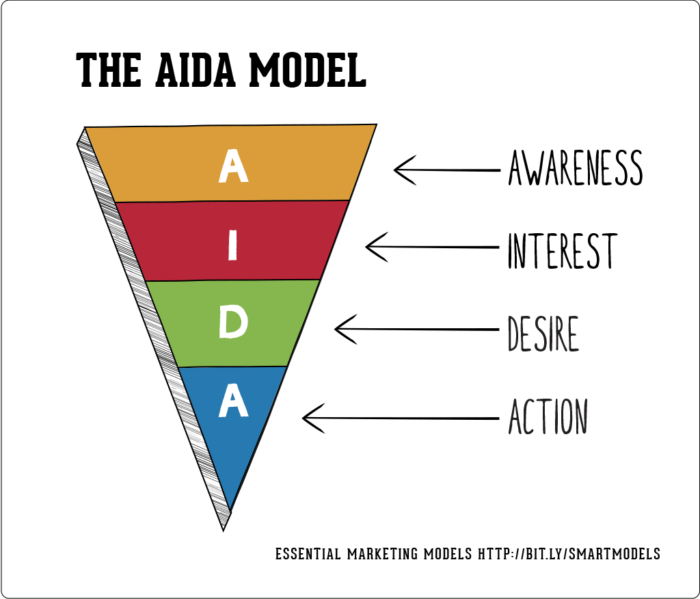
AIDA is an acronym for:
A – Attract Attention
I – Trigger Interest
D – Create a strong Desire
A – Call to Action
Attract Attention: In copywriting, there’s lots of advice on writing a powerful headline.
If the headline is catchy and piques interest, the chances of eventually getting the user to trust you are high. Since the headline is for attracting attention, follow these simple tips to make it great:
- Include specific numbers (preferably an odd number) at the beginning of the headline (e.g., 13 Simple Ways To Design High-Converting Landing Pages).
- Be clear on the headline. Don’t hide the ball. It’s better to write a clear headline that answers your user’s question than to write a clever and confusing one. So, instead of “How to Get Found,” use “5 Simple and Effective SEO Techniques to Optimize For Search Traffic.”
- Include your targeted keywords (search terms) in the headline, to catch the attention of customers.
- Limit your headline to 60 characters (this is especially advisable for SEO).
- Use power words (e.g., Tricks, Secrets, Free, Smart, Powerful, Unknown, etc.)
Build a strong desire: A good marketing campaign is all about discovering the gap between what the customer really wants and the products or website content that you’ve created for them. According to James Gilbert, “good marketers don’t sell products, they create desire.”
There has to be a strong desire, either already present or one that you create yourself. Otherwise, customers aren’t going to take action on what you say.
If you can identify the gap between your customer’s perceived state and their desired state, you can speak to them more personally with compelling copy, which will help persuade them to take whatever action you want them to take.
How do copywriters create strong interest through benefits? Well, they usually display the benefits using subtitles and bullet points within good copy to make them understandable, easily accessed and perceived as important.
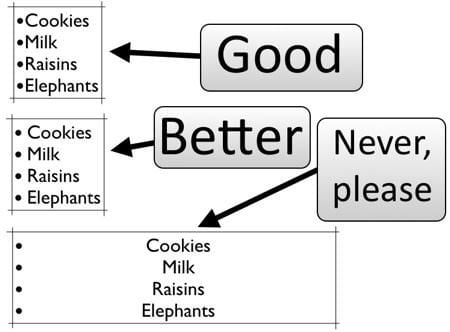
I use bullet points in a lot of my website content because they’re scannable, interest-building and easy to digest. I’ll sometimes combine numbering and bullet points in website copy, to show hierarchy or order of importance:
Call-to-action: The last piece of the AIDA puzzle is the call-to-action. One of the most common mistakes bloggers and marketers make is failing to effectively persuade customers to take action, even after attracting attention, building interest and creating a strong desire.
Depending on your website content, the kind of call-to-action that you’ll use will vary. For example, if you publish an in-depth, high-quality article, then you might ask your readers to leave a comment and share the post.
From experience, I’ve found that if your blog content is truly helpful and you’re consistent, people will naturally link to you and share on any social media platform (Facebook, Twitter, LinkedIn, TikTok, YouTube) where they actively engage with others.
But, to get a higher conversion rate, simply ask readers/customers to do exactly what you want them to do. If you want them to write a comment, just ask them to leave a comment – a specific prompt question can help:
Improve Click-Through Rates
Your customer is pressured to click tons of ads that are thrown at them on a daily basis. The average person is served thousands of ad banners per month. However, when it comes to search click-through rate, there are many variables, including whether search results have images, videos, featured snippets, etc.)
If you want to succeed at content marketing and stay ahead of your competitors, you’ve got to continually improve your knowledge and skills, especially in the area of testing.
Before writing a post on how website content length affects rankings, I had to test it for myself. How else could I draw any conclusions? You have to test, too.
One of the important lessons that I learned, early in my blogging career, is that there is no single rule for improving your conversion rate.
No matter where you get advice from, you know that no one can guarantee specific results. I might set up a split testing campaign today and get a 34% click-through rate on my headlines, whereas you’ll get 44% or less than 10%, even if you and I follow similar strategies. Much of the result depends on skills and on your niche or industry.
Since they’re so effective at improving your conversion rate, you should especially test your headlines.
If you want to increase clicks on your campaigns and you’re wondering where to start, my advice is: start with the headline, not the call-to-action.
The headline is critical. It’s easy to identify a lack of clicks when the CTA is not compelling. It’s much harder to figure out when the headline is actually the culprit, though.
Frequently Asked Questions
What is online marketing?
Online marketing is the practice of digital channels to spread your message about your products or services. Some of the ways you can do this are through paid ads, social media, emails, blogging, or even SEO.
How do I learn online marketing?
The Neil Patel blog is always a great place to start. You can find articles on every area of online marketing, including on-page and off-page SEO, Google Ads, and affiliate marketing. My intention is to give you comprehensive, actionable content you can put into action today.
Is online marketing affiliate marketing?
Sometimes it is, but online marketing covers multiple other areas, from social media to content marketing. Affiliate marketing is just one area of online marketing.
What’s better between online marketing vs traditional marketing?
While there are benefits to both online and traditional marketing, online marketing is often more effective. With online marketing, businesses can reach a larger audience more easily and at a lower cost. Additionally, online marketing allows you to track results and adjust your strategy as needed.
That said, there are still some cases where traditional marketing may be a better option. For example, if you’re targeting a local audience or need to build brand awareness from scratch, traditional methods may be more effective.
Conclusion
When done correctly, online marketing can make you seriously wealthy. Just don’t make the mistake of thinking it’s easy and that big things happen overnight. Of course, there’s always the exception, but for most online marketers, it’s a process that you get better at in time.
It doesn’t matter what background you’re from or work experience you have, thanks to the power of the Internet, everyone has the opportunity to become financially independent through digital marketing.
However, starting your online marketing journey doesn’t mean you can ditch the boss and the nine-to-five or shake the fear of losing your job right away. Nevertheless, if you work at it and stick to the proven methods, who knows where that may take you? You might even become the next Neil Patel!
I hope this guide helps you do just that.
What’s your favorite type of online marketing? Are you building a business with it? Which type of marketing will you learn next? Let me know in the comments!